by Lynn Lee
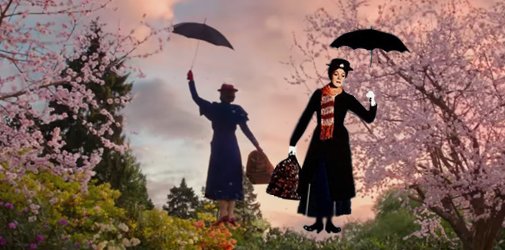
Among the sharper observations I’ve seen regarding Mary Poppins Returns is that it is to Mary Poppins what The Force Awakens was to Star Wars: A New Hope. In each case, the sequel feeds shamelessly off fans’ nostalgia by recreating every beat of the original film – the plot arc, the character dynamics, even the distinctive look of the original, tweaked to reflect the changing mores of the past several decades. In short, it’s the same movie, just repackaged.
Setting aside whether it needed to be made at all, does Mary Poppins 2.0 improve at all on the original formula? In The Force Awakens, the one real added value was the new characters. In many ways they felt like rebooted archetypes from A New Hope, yet for the most part they also felt fresh and intriguing. Is the same true for Mary Poppins Returns? Let's do a side-by-side comparison...
Excluding Mary Poppins herself – partly because her character, unlike the others, is supposed to be virtually unchanged (though that’s debatable), but mostly because the surrounding characters in the first Mary Poppins were a huge and underrated part of what made the film so memorable, we're just looking at them.
THE PATRIARCH
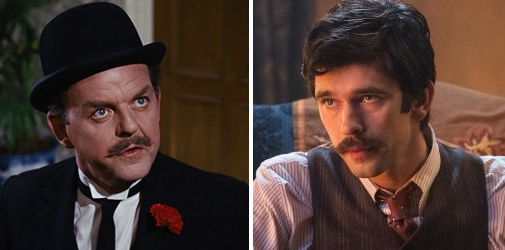
George Banks (David Tomlinson) vs. grown-up Michael Banks (Ben Whishaw)
Much as I love Whishaw, no contest here: George Banks by a country mile. One of the comic joys of the original film was the sight of Tomlinson’s grumpy acolyte of patriarchal order and discipline constantly sputtering at his domestic ideals being totally subverted by a woman he could never quite catch in the act – until his climactic breakdown and surrender to her supercalifragilistic powers at what should have been the worst moment of his life. By contrast, Whishaw does his best, but his mopey, distracted-by-grief widowed artist just feels like a drag.
THE WOMAN OF THE HOUSE
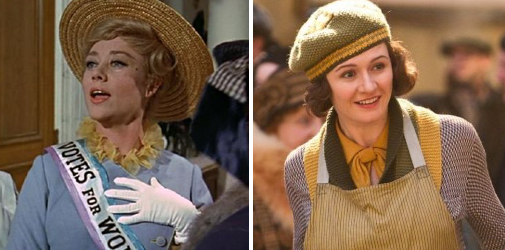
Winifred Banks (Glynis Johns) vs. unseen dead Mrs. Michael Banks (a classically Disney touch, that)
Disney jokes aside, the fairer comparison here is probably between Winifred and her grown-up daughter, Jane Banks (Emily Mortimer), the only thing close to a maternal figure in MPR besides Mary herself. Unfortunately, adult Jane is way too thinly drawn to make much of an impression, her labor organizing sympathies notwithstanding; unlike Winifred’s suffragist, she doesn’t even get a song! By contrast, while Winifred’s character arc might be problematic from a feminist perspective, she will forever leave her mark with “Sister Suffragette.” If she had no other scene, she’d still win this matchup easily.
THE CHILDREN

Young Jane & Michael Banks (Karen Dotrice, Matthew Garber) vs. Annabel, John & Georgie Banks (Pixie Davies, Nathanael Saleh, Joel Dawson)
Even though there’s a trio in the new one, the middle child (as is the wont of many a middle child, alas), John, barely registers a presence. Annabel is compelling as the plucky, self-appointed mini-mom, while Georgie has the distinction of being the one always getting into trouble. However, O.G. Jane and Michael had the advantage of looking like they’d stumbled out of an Edward Gorey storybook into a much pleasanter universe. This one’s a draw.
THE HELP

Younger Ellen (Hermione Baddeley) vs. older Ellen (Julie Walters)
Julie Walters is a national treasure, but her absent-minded, mellowed-out take on the faithful housekeeper feels vague and fuzzy in comparison to Baddeley’s prickly, tart-tongued, perpetually pop-eyed housemaid, especially when paired and/or sparring with Reta Shaw’s irascible cook. Young Ellen wins.
THE LOYAL SIDEKICK

Bert, the jack-of-all-trades (Dick Van Dyke), vs. Jack the lamplighter (Lin-Manuel Miranda)
Atrocious cockney accent aside, Dick Van Dyke’s charisma (which still burns bright, as we’ll see later) and knack for physical comedy are pretty damn irresistible. While Miranda is perfectly likable and acquits himself well on the singing and dancing front, he lacks the sunny silliness that made Bert so endearing – and enduring.
THE ECCENTRIC (AND GRAVITY-CHALLENGED) RELATIVE
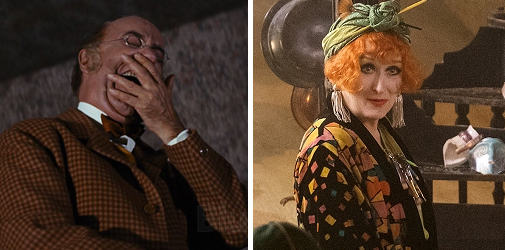
Uncle Albert (Ed Wynn) vs. Topsy (Meryl Streep)
This is more the fault of the writing and direction than the actor, but Uncle Albert’s tea party on the ceiling still makes me laugh today as an adult – though mostly, perhaps, because of Julie Andrews’ perfect deadpan throughout – while I actually dozed off during the Topsy scene, which seemed to go on far too long. Advantage Uncle Albert.
THE OLD LADY OFFERING PRICELESS INVESTMENTS
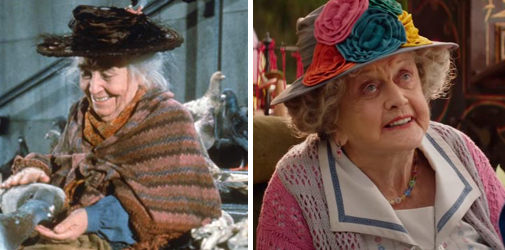
The bird woman (Jane Darwell) vs. the balloon lady (Angela Lansbury)
Even in a bit part, who can resist Dame Lansbury? In just one brief scene, she conveys both a sweet old lady and delicious side-eye as Colin Firth’s shady banker (see below) fails her balloon test. Bird woman, by contrast, is far less expressive and says only three words. That said, those three words also form the base of the most beautiful and melodically haunting song from Mary Poppins, and that’s saying something.
THE VILLAINOUS BANK OFFICIAL

Mr. Dawes, Jr. (Arthur Malet) vs. William Wilkins (Colin Firth)
Firth gets both more and less to work with here – a more substantial role, but also more rote villain material – which might explain the oddly half-hearted, almost phoned-in tone to his villainy (his cartoon counterpart in the animated sequence is frankly much more sinister). Still, his ruefulness works well in his final scene, noted above, with the balloon lady. On the other hand, Mr. Dawes, Jr. does get to go from punching out George Banks’ hat to fretfully wailing “Daddy!” in a single scene. I’ll call this one a tie.
THE UNLIKELY SAVIOR
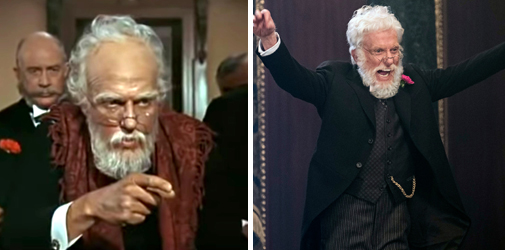
Mr. Dawes, Sr. / Mr. Dawes, Jr. (Navckid Keyd, aka Dick Van Dyke again)
Trick question! Neither character is meant to be taken the least bit seriously, of course, but both are enormously entertaining. While the former gets more screen time, the Dawes of Mary Poppins Returns gets the edge for DVD’s still being able to cut a rug and steal a scene at the age of 92.
OVERALL VERDICT: The Mary-come-lately characters for the most part aren’t a patch on the originals. They also pinpoint one of the other major reasons the sequel, for me, fell flat: it’s not nearly as funny as the first movie. There’s nothing to match the pure hilarity of George Banks trying to figure out how Mary Poppins found the children’s advertisement he thought he’d burned, or his half-manically recounting the corny “I met a man with a wooden leg named Smith” joke to the bank president, or the hysterical responses of the household staff to the spectacle of chimney sweeps dancing through the house (“It’s the master! / Step in time”). Even neighbor Admiral Boom, who like Mary is carried over more or less intact from the original, is mostly denied his kooky clockwork punch in the sequel. Mary Poppins Returns may be a pleasant enough trip down memory lane, but it lacks the comic brightness and sheer goofiness of its predecessor. And that’s due in no small part to the strength of Mary Poppins’ original ensemble, which has proven a tough act to follow.
Readers, how do you think Mary Poppins Returns and its characters stack up to the original?